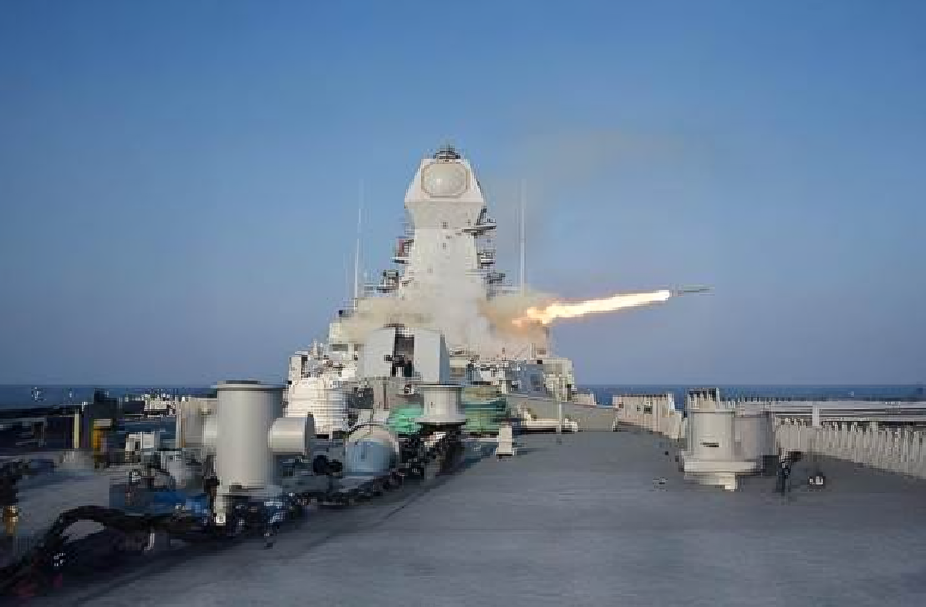
- The Extended Range Anti-Submarine Rocket (ERASR) user trials were successfully carried out by the Indian Navy from the stealth corvette INS Kavaratti, demonstrating India’s increasing defensive capability.
- ERASR is an advanced underwater weapon designed to destroy adversary submarines up to eight kilometers away.
- The ERASR technology is very important strategically since it has the capability to neutralize undersea threats in high-risk naval areas.
- The ERASR’s successful user trials from INS Kavaratti have greatly improved India’s anti-submarine warfare capabilities.
From the Surface, We Strike the Silent Depths
A Leap into the Depths of Maritime Supremacy
India’s advancements in domestic naval power are helping it gradually transform into a true water navy—a maritime force with global reach and deep-sea dominance. With vessels like the INS Kavaratti and technological advancements like ERASR, India is strengthening its military capabilities and establishing itself as the region’s guardian. This move is a component of Atmanirbhar Bharat’s larger vision, which views self-reliance as a strategic route to security and sovereignty rather than merely a catchphrase. The Extended Range Anti-Submarine Rocket (ERASR) user trials were successfully carried out by the Indian Navy from the stealth corvette INS Kavaratti, demonstrating India’s increasing defensive capability. A major step toward India’s objective of developing, testing, and deploying advanced anti-submarine warfare (ASW) technology domestically, these tests were conducted in the Arabian Sea in June 2025. Combining internal research, strategic innovation, and real-world operational application, the ERASR was created by the Defence Research and Development Organisation (DRDO) with significant assistance from the Armament Research and Development Establishment (ARDE) in Pune.
ERASR (Extended Range Anti-Submarine Rocket)
The Extended Range Anti-Submarine Rocket (ERASR) is an advanced underwater weapon designed to destroy adversary submarines up to eight kilometers away. Comparing this to older ASW depth charges, there is a noticeable improvement. By bridging the operational gap between expensive long-range torpedoes and low-range explosives, ERASR gives the Indian Navy greater adaptability to quickly and successfully neutralize subsurface threats. The system expands the Navy’s area of influence below the sea and significantly improves survivability by enabling surface ships to strike underwater threats from a distance.
Key Components of ERASR
EUM (End-Use Monitoring) and Responsibility
Like other significant impact defensive systems, ERASR is subject to stringent rules for responsible deployment. “End-use monitoring” (EUM) encompasses a wide range of procedures intended to guarantee that military equipment is utilized exclusively for its intended purposes.
The Indian Navy keeps meticulous records of its inventory and storage, and in the case of ERASR, DRDO enforces encrypted control over technical data. Only authorized workers are allowed to handle the rocket, and GPS-based data tracking keeps track of each deployment. Shelf-life monitoring, system health checks, and anti-tamper encryption are routine procedures. Operational safety, transparency, and compliance with national and international defense requirements are all provided by these actions.
Operational Excellence and Strategic Importance
The ERASR technology is very important strategically since it has the capability to neutralize undersea threats in high-risk naval areas. ERASR presents a valuable advantage in maintaining maritime security as stealth submarine operations in the Indian Ocean Region (IOR) rise. Critical chokepoints, like the Strait of Malacca, need to be secured by preventing and driving out enemy submarines. The capability of the system to instantly interfere with enemy sonar operations using multi-rocket salvos gives it tactical superiority. ERASR augments defensive protection along India’s seafronts, such as the Arabian Sea and the Bay of Bengal. Its deployment on advanced naval ships also serves as an effective deterrent by enhancing India’s underwater warfare capabilities and minimizing the risk of hostile invasions.
India’s Blue Water Navy: Strategic Ambitions and Future Outlook
The ERASR program is a future-oriented concept planned to be scalable and adapt for future military requirements, along with the current defense capabilities of India. Future improvements will consist of AI-based targeting algorithms, multi-mode fuzing with acoustic and magnetic triggers, unmanned surface and undersea vehicle interactions, and adaptable warhead designs for a variety of mission profiles. The motivation behind these enhancements is to maintain ERASR relevance in the Indian Navy’s current operating environment. India’s change of strategy to become a genuine blue sea navy is echoed in these homegrown initiatives. India is asserting its maritime supremacy over the Indian Ocean Region with vessels such as the INS Kavaratti and indigenously developed systems like ERASR. This transition is a result of the Atmanirbhar Bharat campaign, which implies greater self-sufficiency in advanced naval technology and reduced dependence on imports.
Conclusion
The ERASR’s successful user trials from INS Kavaratti have greatly improved India’s anti-submarine warfare capabilities. It illustrates India’s ability to provide reliable, homegrown solutions for modern marine security challenges. India is well-positioned to respond strongly to submarine threats thanks to the ERASR system’s increased operational compatibility, cost-effectiveness, and range. As India works to safeguard its maritime interests, systems like ERASR are crucial for establishing control, enhancing deterrence, and supporting national security.
References
- https://www.pib.gov.in/PressReleasePage.aspx?PRID=2143225
- https://english.mathrubhumi.com/features/specials/indias-erasr-anti-submarine-rocket-wqx2auqy
- https://www.moneycontrol.com/news/india/india-successfully-tests-extended-range-anti-submarine-rocket-from-ins-kavaratti-13244747.html
- https://www.drishtiias.com/state-pcs-current-affairs/successful-trials-of-erasr
Piyush Anand is a Biotechnology Engineering student at Chandigarh University. His primary interest lies in International Affairs, Defence and Strategy. Views expressed are the author’s own.
